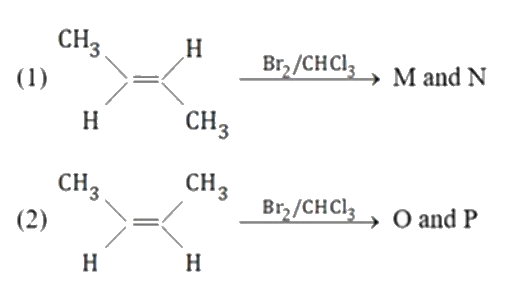Correct statement for E1 Reaction is :
It is a two step process.
Rearrangement is possible
Good leaving group favours
All of these
The correct Answer is:D
To solve the question regarding the correct statements for an E1 reaction, we will analyze each of the provided options step by step.
Step 1: Understanding E1 Reaction
E1 stands for unimolecular elimination reaction. It is a type of elimination reaction that occurs in two distinct steps.
Step 2: Analyzing the Steps of E1 Reaction
1. First Step - Carbocation Formation:
- In the first step, the substrate (usually an alkyl halide) undergoes ionization to form a carbocation intermediate. This step is the rate-determining step and is unimolecular, meaning it depends only on the concentration of the substrate.
2. Second Step - Elimination:
- In the second step, a base removes a proton (H+) from a neighboring carbon, leading to the formation of a double bond and the elimination of the leaving group (e.g., halide ion).
Step 3: Evaluating the Options
- Option A: It is a two-step process:
- This statement is correct as we have established that E1 reactions occur in two steps.
- Option B: Rearrangement is possible:
- This is also true. The carbocation formed in the first step can rearrange to a more stable carbocation if possible (e.g., from a secondary to a tertiary carbocation).
- Option C: Good leaving group favors the reaction:
- This statement is correct as well. E1 reactions are favored by substrates with good leaving groups (like halogens) because they facilitate the formation of the carbocation.
- Option D: All of these:
- Since all the previous statements (A, B, and C) are correct, this option is also correct.
Conclusion
The correct answer is Option D: All of these.
---
E1 stands for unimolecular elimination reaction. It is a type of elimination reaction that occurs in two distinct steps.
1. First Step - Carbocation Formation:
- In the first step, the substrate (usually an alkyl halide) undergoes ionization to form a carbocation intermediate. This step is the rate-determining step and is unimolecular, meaning it depends only on the concentration of the substrate.
2. Second Step - Elimination:
- In the second step, a base removes a proton (H+) from a neighboring carbon, leading to the formation of a double bond and the elimination of the leaving group (e.g., halide ion).
- Option A: It is a two-step process:
- This statement is correct as we have established that E1 reactions occur in two steps.
- This is also true. The carbocation formed in the first step can rearrange to a more stable carbocation if possible (e.g., from a secondary to a tertiary carbocation).
- This statement is correct as well. E1 reactions are favored by substrates with good leaving groups (like halogens) because they facilitate the formation of the carbocation.
- Since all the previous statements (A, B, and C) are correct, this option is also correct.
The correct answer is Option D: All of these.
Topper's Solved these Questions
- ORGANIC REACTION MECHANISMS-IVBOOK - RESONANCE ENGLISHCHAPTER - ORGANIC REACTION MECHANISMS-IVEXERCISE - Exercise-1 Part-3
2 Videos
- ORGANIC REACTION MECHANISMS-IVBOOK - RESONANCE ENGLISHCHAPTER - ORGANIC REACTION MECHANISMS-IVEXERCISE - Exercise-2 Part-1
11 Videos
- ORGANIC REACTION MECHANISMS-IVBOOK - RESONANCE ENGLISHCHAPTER - ORGANIC REACTION MECHANISMS-IVEXERCISE - APSP PART-3
22 Videos
- ORGANIC REACTION MECHANISMS - IIBOOK - RESONANCE ENGLISHCHAPTER - ORGANIC REACTION MECHANISMS - IIEXERCISE - APSP Part - 3
22 Videos
- PERIODIC TABLE & PERIODICITYBOOK - RESONANCE ENGLISHCHAPTER - PERIODIC TABLE & PERIODICITYEXERCISE - ORGANIC CHEMISTRY(BASIC CONCEPTS)
27 Videos
Similar Questions
Knowledge Check

Correct statement about above reaction is:AA =cis-2-chlorocyclohexanol,BA = trans-2-chloro cyclohexanol,CA = trans-2-chlorocyclohexanol,DA = cis-2-chlorocyclohexanol,
In the reaction sequence.

Correct statement regarding B is :
View SolutionIdentify the correct statement about the reaction -

View Solution
Correct statement regarding these two reaction I and II
View SolutionElectronic configuration of anatom

Choose the correct statement regarding this E.C.
View SolutionConsider the following reaction

Correct statement regarding the given product is
View SolutionThe correct statement for the following addition reaction is

View SolutionThe correct order for E2 reaction with alc. KOH will be :-

View Solution
